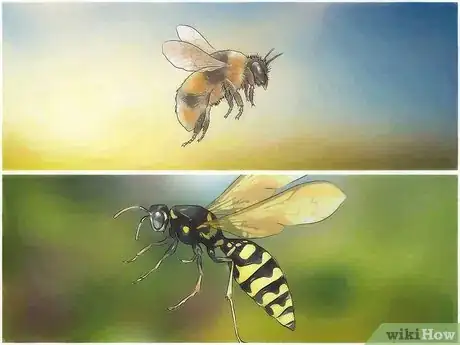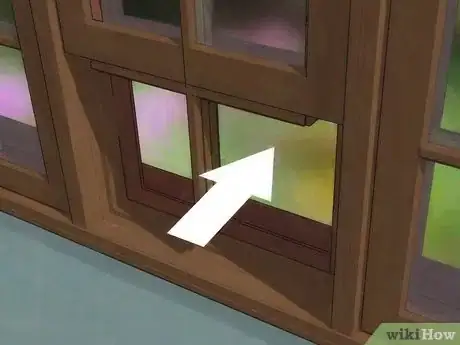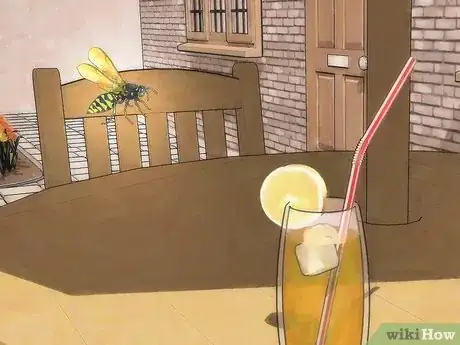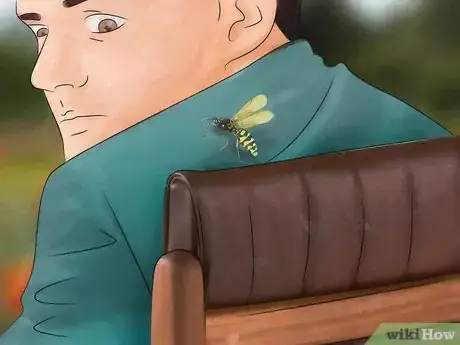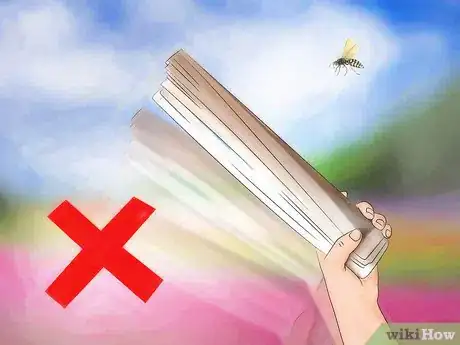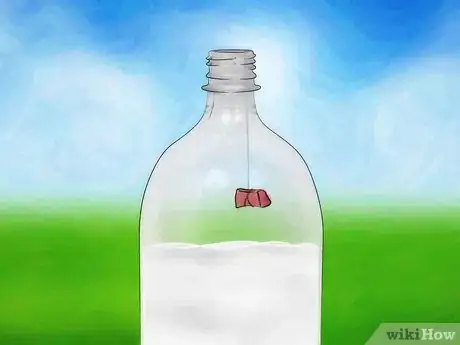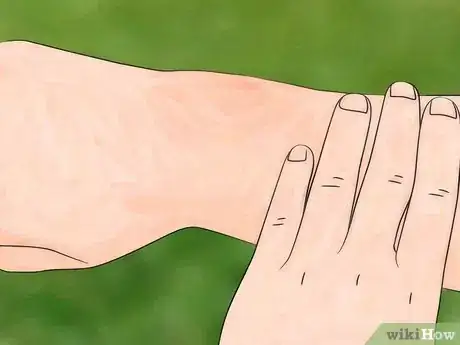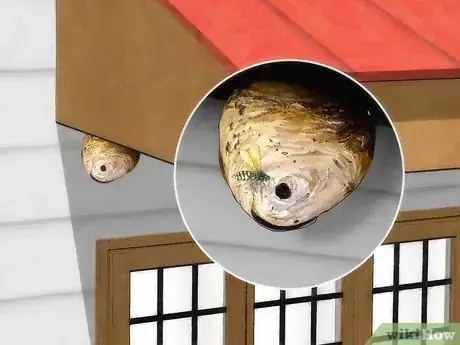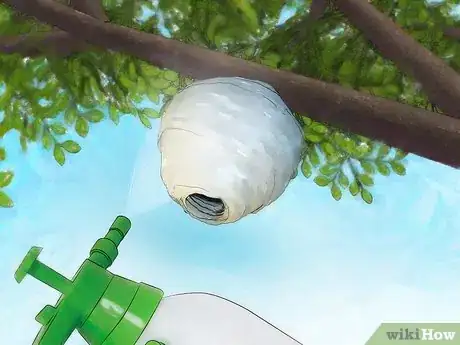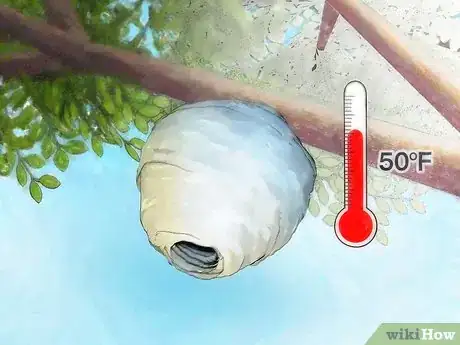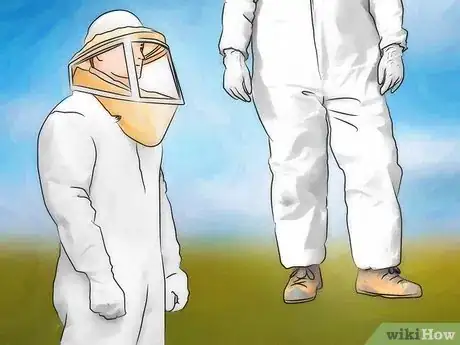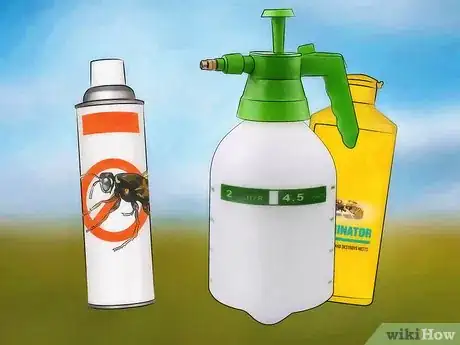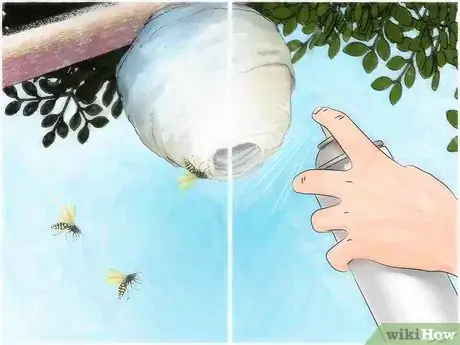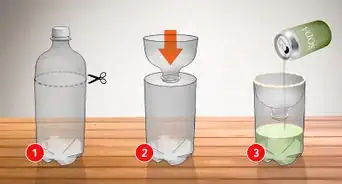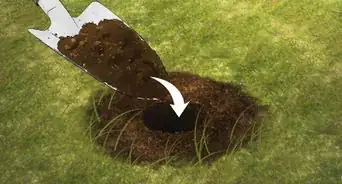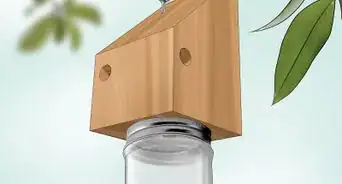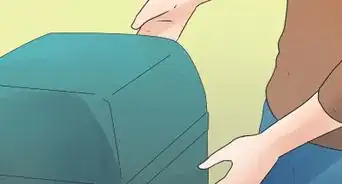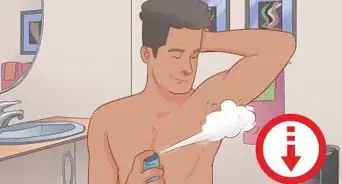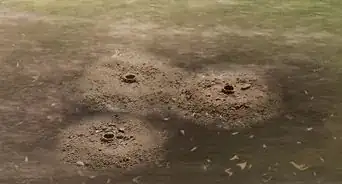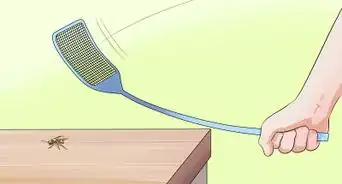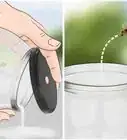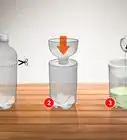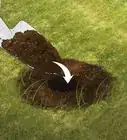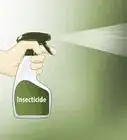This article was co-authored by Chikezie Onyianta. Chikezie Onyianta is a Pest Control Specialist and the Owner of EcoFusion Pest Control, serving communities in New Jersey, Pennsylvania, and New York. With over 5 years of experience, he specializes in pest control in both residential and commercial spaces. A graduate of Essex County College, Chikezie and EcoFusion assist in rodent, roach, and ant pest control as well as bed bug services.
There are 10 references cited in this article, which can be found at the bottom of the page.
wikiHow marks an article as reader-approved once it receives enough positive feedback. This article received 23 testimonials and 85% of readers who voted found it helpful, earning it our reader-approved status.
This article has been viewed 689,498 times.
Yellow jackets are the wasps which most often come into conflict with humans. Unlike bees and paper wasps, yellow jackets are socially active, aggressive food gatherers who can become quite pugnacious when disturbed. Yellow jackets are considered beneficial insects, but it’s sometimes necessary to permanently deal with these surly wasps and their nests.
Steps
Killing a Solo Yellow Jacket
-
1Verify it’s not a honeybee. Difficult in the heat of the moment, with the creature buzzing around your head, but it’s an important distinction. Yellow jackets are wasps, and one of the more aggressive varieties. Unlike several other common wasps, they share the honeybee’s alternating, banded, black-and-yellow color scheme. These wasps have thinner bodies than bees, appearing less round and hairy, and have wings as long as their body.[1]
- It’s important not to kill honeybees, who fulfill an important role in the ecosystem without exhibiting overly aggressive toward humans. To put their contribution in perspective: it’s been said that bees are responsible for one in every three bites of food that we eat!
- Bees will die after a single sting, and are not typically aggressors in their interactions with humans. They’re docile and sting only in an effort to defend and warn their hive.[2] Wasps, however, can sting an indefinite number of times and will not hesitate to.
-
2Open the doors and windows if you’re inside. The goal here is elimination of the threat. Sometimes that can be accomplished by providing the wasp with an escape route. Herding the yellow jacket is not recommended, however, as your efforts may put you at unnecessary risk of being stung.
- You should not, however, open a window or door that sits directly next to a known yellow jacket nest.
Advertisement -
3Leave any food which they’re interested in. Efforts to reclaim any food and drink will anger the wasp. Leave anything that it’s currently landed on alone. Quickly cover and seal away all other food and drink, then remove it from the yellow jacket’s vicinity.[3]
-
4Stay calm if the yellow jacket lands on you. Erratic movements will only increase the likelihood of being stung. If it lands on you, refrain from making any sudden movements. Ideally, you’ll wait for the wasp to fly away of its own accord. If that tactic isn’t working, use slow, gentle efforts to move it along.
-
5Avoid antagonizing the wasp. Rolled-up newspapers and flyswatters can kill a yellow jacket, but physical combat can open you up to a world of hurt. Striking and failing to kill the wasp will only invite further stings.[4]
- Similarly, attempting to spray a single yellow jacket with insecticide of any sort is not recommended. It will make a mess if used indoors, and can be dangerous to anybody in the vicinity.
- Killing a wasp (or inciting a sting) can also spark extreme aggression from its compatriots. Wasp venom contains an "alarm venom," which will draw other yellow jackets in and mark you as a target. [5]
-
6Lure and trap the wasp with food. Yellow jackets often come into conflict with humans over food. They can be found buzzing around trash cans, and are particularly fond of fruit, meat, and sugary drinks. This can be used to your advantage: if the wasp isn’t already crawling on a piece of food you had out, try using some to coerce it into landing.
- Place food inside a sealable jar, or a soda bottle with a screwable cap. Once the yellow jacket has landed, seal the wasp away and dispose of the bottle (or release it once you’re in an appropriate environment).
-
7Create a more sophisticated, soapy trap. Fill a bottle or bucket with soapy water, and suspend a small piece of protein (lunchmeat works well) from string, 1-2 inches above the water. Once the yellow jacket retrieves the protein, they’ll fall into the soapy water and drown. [6]
- Mesh can be place atop the bucket if there’s concern over other animals eating your protein.
Dealing with a Nest
-
1Ensure you’re not allergic. It’s wise to rule out an as-of-yet unknown allergy to wasps before you place yourself in a situation where you may, if things go poorly, be stung multiple times. If you can’t definitively say whether or not you’re allergic, contact your medical care provider to schedule an allergy test.
- Wasp stings can be life-threatening, depending on the severity of a person’s allergy. The stings can trigger anaphylactic shock within minutes, leading to swelling, fainting, and difficulty breathing.
-
2Locate the nest. Yellow jackets are cavity-nesting insects.[7] They make their nests in the ground, in eaves of houses, beneath porches, and sometimes inside the voids of walls. How you deal with the nest will depend on its location.
- If the whereabouts of the nest are still unknown to you, it might be necessary to lure a yellow jacket in with a sweet treat, then follow its flight path back to the nest. Yellow jackets move fairly directly when entering and exiting their nest, and do not swoop or turn.[8] Any bit of meat, jelly, tuna, wet cat food, or soda can serve as effective bait.
-
3Assess the infestation. Smaller nests can be handled by a quick spray-and-escape, but larger nests will require you to take more thorough protective measures. Also, the sites that yellow jackets choose for their nests are often in spaces difficult to reach and treat. If you become uncomfortable, intimidated, or at any point feel unsafe in dealing with the nest, you should call a professional pest control service to take over.
- Nests are generally begun by a single female in the Spring, and grow throughout the year before dying. In hotter climates with fewer freezes, e.g. southern U.S. States, nests can survive from year to year and grow to be extremely large and populous.[9] This, however, is fairly rare.
- If the nest appears to be large and spiral-shaped, you may actually be dealing with hornets. If it resembles an off-white honeycomb, the nest might belong to paper wasps, less aggressive cousins to yellow jackets.
-
4Time it right. Yellow jackets are far more reluctant to fly when temperatures drop below 50 °F (10 °C). As a result, they are inactive during winter, gain strength in late spring and summer in order to feed their young, and become more active and aggressive around people during fall when food supplies run out. The best time of year to kill a wasp nest is in late spring or early summer when the queen's newborn colony is embedded in the nest.
- Yellow jackets are also much more active during the day. Although you’ll have less visibility, dealing with the nest at night will mean fewer active wasps for you to rumble with.
- If you don’t live in an area that remains hot year-round, the nest will likely die in the winter. If it’s already late fall, you might be better served by waiting the yellow jackets out—they’re at their most aggressive in fall.
-
5Suit up. If you decide to handle the nest yourself, you will want to expose as little of your skin as possible. Wear long sleeves, pants, high socks, and a beanie pulled low over your ears. Dress in layers, and don both boots and gloves.[10] A scarf worn over the mouth and nose can protect the lower face, and safety goggles can be purchased cheaply at any home improvement store to shield your eyes.
- Yellow jackets, though they can become a nuisance to humans, are still fulfilling an import role in nature. They pollinate flowers and predate flies, caterpillars, spiders, and flora-destroying pests.[11] Because of this, it’s a good idea to avoid bright colors, which can be mistaken for flowers.
- Cover flashlights with red cellophane, or use red bulbs. Yellow jackets can't see in red light, and so won't be alerted by your flashlight if you’re approaching at night (as you should be).[12] If you don't have cellophane, aim your flashlight away from the nest on your nighttime approach.
-
6Attack the nest. Synthetic wasp nest killers work quickly, and can be applied to the colony by spraying directly into the nest—but these killers contain dangerous toxins that require extreme care around food, pets and humans. As an alternative, organic wasp killer chemicals use biodegradable oils and acids which are safer around other life.[13] Both options are available as a spray or as a powder.
- Aerosols are often designed to spray up to twenty feet. Use this to your advantage, and spray aerial nests from the ground if able. Ladders will significantly decrease your mobility, and can prove dangerous if attacked by the wasps while climbing.
- If the nest is in the ground, cover the nest with soil or dirt immediately after spraying or dusting it.
- For exterior nests, spray the aerosol directly into the nest according to package directions. Dust is best administered via a turkey baster.
- Spraying the nest with hot, soapy water is also an option, thought not nearly as fast-acting. Thoroughly mix a third of a cup of detergent into half a gallon of water, then apply to the nest through a spray bottle. You’ll need to spray the nest several times a day, for several days.
- Have your path back to safety (preferably back inside a house) planned out in advance. After you begin to spray, you should expect to have 10-15 seconds maximum to make your way back inside.
-
7Wait a week to ensure success. If you’ve sprayed the nest with any chemicals, you’ll typically need to leave the nest alone for a week. There’s no guarantee that all of the nest’s wasps were inside when you treated it, so you should allow those yellow jackets which were out and about time to come back to their nest, which will expose them to the lethal chemicals you’ve applied.
-
8Dispose of the nest. It’s important that you properly handle the yellow jacket’s nest after you’ve taken care of its inhabitants. Simply knocking a hanging nest down can lead to dogs or other neighborhood animals becoming exposed to the chemicals you used; if you sprayed the nest, knock the nest loose with a broom or shovel, then bag it up.
- If—for whatever reason—you’d prefer to keep the nest in its place, that’s also okay. It’s extremely rare for yellow jackets to re-use old nests. [14]
- Some like to hold onto wasp nests, captivated by their intricate, natural aesthetic. While yellow jacket nests aren’t as exotic as some, feel free to display the nest. Potential eggs cannot hatch and survive without feeding and care, so if the nest has been inert for the recommended week you’re in the clear. [15]
Expert Q&A
-
QuestionWhat's the best type of bait to use in a yellow jacket trap?
 Chris ParkerChris Parker is the Founder of Parker Eco Pest Control, a sustainable pest control service in Seattle, Washington. With over seven years of experience, Chris specializes in Integrated Pest Management and doesn’t use any chemicals for pest removal. He offers removal services for ants, rodents, fleas, spiders, wasps, and more. Chris is a certified Commercial Pesticide Applicator in Washington State and received his bachelor’s from the University of Washington.
Chris ParkerChris Parker is the Founder of Parker Eco Pest Control, a sustainable pest control service in Seattle, Washington. With over seven years of experience, Chris specializes in Integrated Pest Management and doesn’t use any chemicals for pest removal. He offers removal services for ants, rodents, fleas, spiders, wasps, and more. Chris is a certified Commercial Pesticide Applicator in Washington State and received his bachelor’s from the University of Washington.
Founder, Parker Eco Pest Control There are commercially available pheromone lures specifically formulated for yellow jackets. Those will work better than any kind of bait that you would find in your kitchen.
There are commercially available pheromone lures specifically formulated for yellow jackets. Those will work better than any kind of bait that you would find in your kitchen. -
QuestionIf the yellow jackets can't go back in the nest, do they die or relocate?
 Community AnswerUsually, they find another queen and support that nest but if not they can certainly die from exposure to the elements, particularly in the fall because of the much cooler nights. As mentioned above, they don't usually move at temps below 50°F.
Community AnswerUsually, they find another queen and support that nest but if not they can certainly die from exposure to the elements, particularly in the fall because of the much cooler nights. As mentioned above, they don't usually move at temps below 50°F. -
QuestionWhat can I do to get rid of an underground nest other than using poison?
 Community AnswerWait until all the insects are inside the underground nest at night. Put a bucket or large bowl over the opening and mound dirt around the bottom rim of the bucket. Check the area the next day to see if the yellow jackets have found another exit from their nest. Wait until night and cover that hole as well. This works because yellow jackets do not excavate their own nests, they use existing holes left behind by gophers or mice. Once you have the holes covered they will die inside the nest. It's up to you when you feel like enough time has passed to remove the bucket, but I wait a couple of weeks if not longer.
Community AnswerWait until all the insects are inside the underground nest at night. Put a bucket or large bowl over the opening and mound dirt around the bottom rim of the bucket. Check the area the next day to see if the yellow jackets have found another exit from their nest. Wait until night and cover that hole as well. This works because yellow jackets do not excavate their own nests, they use existing holes left behind by gophers or mice. Once you have the holes covered they will die inside the nest. It's up to you when you feel like enough time has passed to remove the bucket, but I wait a couple of weeks if not longer.
Warnings
- Those who are severely allergic to wasp stings often carry an Epi-Pen in order to combat anaphylactic shock. If someone you’re with in stung by a wasp and appears to be having difficulty breathing, ask them about their Epi-Pen, and if they’re allergic to wasps. They may require swift medical attention.⧼thumbs_response⧽
- Before applying yellow jacket killer to ground surfaces, read product label warnings carefully to be sure that the product is safe for soil and water.⧼thumbs_response⧽
References
- ↑ http://carolinamountainclub.org/enews/enews%20archive/yellowjackets.pdf
- ↑ http://www.pbs.org/newshour/updates/honeybee-sting-kill-bee/
- ↑ http://carolinamountainclub.org/enews/enews%20archive/yellowjackets.pdf
- ↑ http://www.gardeners.com/how-to/yellow-jackets/7700.html
- ↑ http://carolinamountainclub.org/enews/enews%20archive/yellowjackets.pdf
- ↑ http://www.ipm.ucdavis.edu/PMG/PESTNOTES/pn7450.html
- ↑ http://www.ipm.ucdavis.edu/PMG/PESTNOTES/pn7450.html
- ↑ http://www.techletter.com/Archive/Technical%20Articles/yellowjackettracking.html
- ↑ http://www.clemson.edu/cafls/departments/esps/factsheets/medvet/yellow_jackets_mv03.html
- ↑ Chikezie Onyianta. Pest Control Specialist. Expert Interview. 1 April 2021.
- ↑ http://www.gardeners.com/how-to/yellow-jackets/7700.html
- ↑ http://pestkill.org/insect/insects/yellow-jackets/
- ↑ http://pestkill.org/insect/insects/yellow-jackets/
- ↑ http://extension.oregonstate.edu/gardening/node/467
- ↑ http://www.ipm.iastate.edu/ipm/iiin/bhornets.html
About This Article
To kill a yellow jacket, start by putting a small piece of fruit or a sugary drink inside a sealable jar or soda bottle, since yellow jackets are attracted to sweets. Then, wait for the yellow jacket to land, seal the jar or bottle, and dispose of it safely. If you’re dealing with a nest, put on safety goggles and cover as much of your skin as possible before spraying the nest with a commercial wasp killer. If possible, try to spray the nest during the night when wasps are more sluggish and pose less of a threat. To learn how to dispose of a nest after you’ve killed the yellow jackets inside, keep reading!
